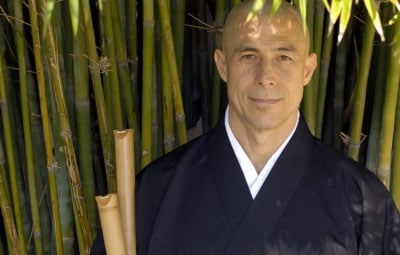
My motivation behind teaching the shakuhachi is more than just trying to earn a living doing what I do best. It is also more than sharing with others what I enjoy doing. Here are the most important reasons why I teach shakuhachi to others – in a long, round about way:
The main or original pieces for the shakuhachi are called honkyoku. I like honkyoku. They are, amongst the pieces I learned from my teachers, what I value the most. They are why I began playing the shakuhachi in the first place. The word, honkyoku literally means “main piece”. These pieces were created, performed and transmitted within the context of Zen Buddhism. They are spiritual practice.
Another meaning for honkyoku comes from the expression, honnin no kyoku. This means “one’s own piece”, or “the piece of the person in question”, that is, your piece. To learn a honkyoku is to make a piece your own. Two teachers, Sakai Chikuho II and Yokoyama Katsuya taught me. That is, I spent many hours of my, and their time listening and being listened to, learning a number of pieces, for example Hachi Gaeshi (Returning the Bowl).
Though most of you have experienced a shakuhachi lesson, let me tell you how a typical one for me was. My teacher would first play a phrase of, for example, Hachi Gaeshi. We would play it together. Then I would be asked to play it on my own. Usually, the teacher would tell me that I was not playing it right, and the process would be repeated. Eventually, we would proceed to the next phrase, and the next, until I had played all of the phrases in Hachi Gaeshi by myself.
By the way, mendicant priests played the piece Hachi Gaeshi during pilgrimages. Donors would give the monks offerings, usually vegetables or uncooked rice in a bowl. The monks would gratefully receive the offering, usually by emptying the bowl of food into their pouch, return the bowl to the donor, and then play “Returning the Bowl”. In other words, playing Hachi Gaeshi is expressing gratitude.
Over the next few lessons, I would play the entire piece both in unison with my teacher and alone. At some point, my teacher would say, “All right. Now we will go on to another piece.” With Yokoyama-sensei, I would have to play the piece by heart, without notation, before going on to a new piece.
Frequently, in particular with Yokoyama-sensei, I would be asked without warning to play a piece I had learned previously. But even after I had played Hachi Gaeshi by heart to the satisfaction of the teacher, and we had begun a new piece, the idea was that I still wasn’t finished with it. Even after I had played Hachi Gaeshi successfully a second time without warning, I still did not have the piece. I had not yet made it a honnin no kyoku. Hachi Gaeshi wasn’t mine – yet.
The idea was that the piece was mine only after I had in turn given it away.
*****************
Review – World Shakuhachi Festival O8 DVD Set
If you like the sound of the Japanese flute, the shakuhachi, then here is your change to view and listen to the long awaited DVDs of the Sydney World Shakuhachi Festival 2008.
This set of 8 DVDs present some of the best shakuhachi performers in the world in concert, playing a variety of shakuhachi music styles and genres. Each DVD has it’s unique character, focusing on specific elements played during the festival.
The shakuhachi is a very simple instrument yet it takes years and years to master, some people might not even get a sound out of it after trying for a couple of weeks. The flute was first introduced into Japan from China in the eighth century and has been used in a spiritual context since the 15th century. In the Edo period (1600-1868), playing the shakuhachi was the primary meditative practice of a sect of Zen Buddhist monks who called themselves Komuso (priest of nothingness). They wore distinctive basket like hats, which covered their complete head as a symbol of their renouncement of attachment and ego.
These DVDs include performances of some of the best shakuhachi players in the world, like Riley Lee, Reibo Aoki II, Kodo Araki V, Kohachiro Miyata, Bronwyn Kirkpatrick, Elisabeth Brown and many more. Watching and listening to these beautiful DVDs you will be taken on a journey of inner peace and self discovery from a traditional and modern Japanese perspective.
To buy click here:
http://www.rileylee.net/WSF08_DVD.html
